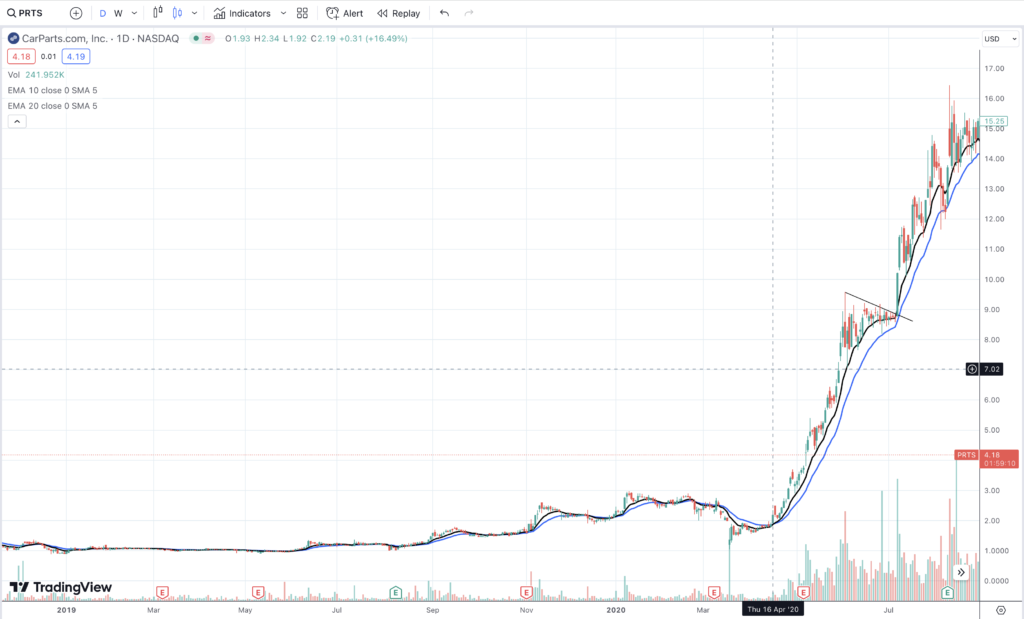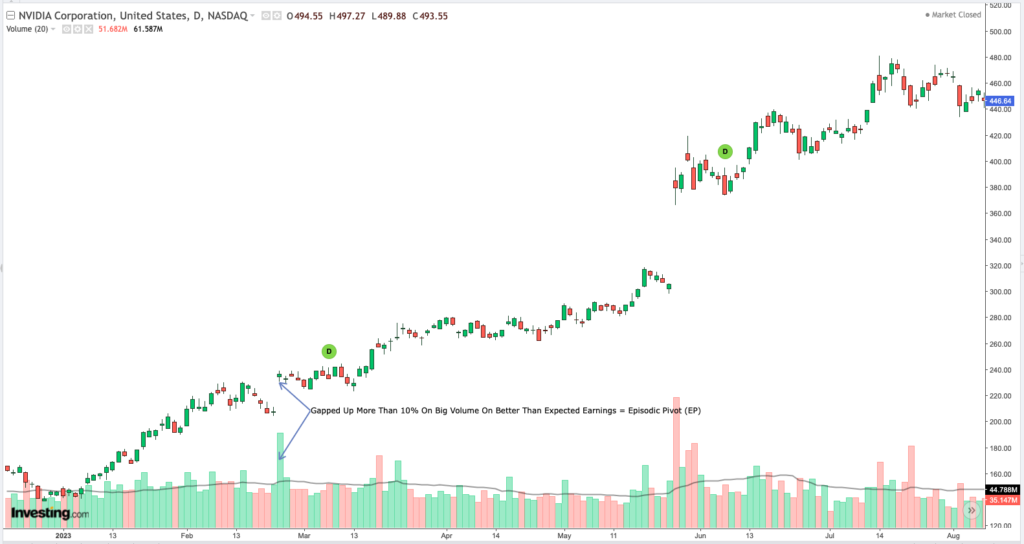The Two Trading Strategies That Kristjan Kullamägi Uses To Make Huge Returns?

Kristjan Kullamägi’s Track Record
You probably know him as Qullamaggie but his real name is Kristjan Kullamägi and he has stated publicly, on several occasions, that he has made tens of millions of dollars since he started trading. His earnings put him among the small handful of traders who actually make money in this business.
To put this in perspective, you have to understand that only about 2% of traders ever make any consistent money and can truly claim to make a living from trading. That means the vast majority of people who attempt to make it in the trading business eventually fail.
This website, and more specifically, the features that I write are focused on the successful 2%. We want to know who they are and how they did it. Today, we will profile Kristjan Kullamägi and take a look at how he got to where he is now and attempt to lay out his exact trading strategy so you can see how he actually trades.
His Background
Kristjan is Swedish. I have known a few Scandinavian/Nordic traders in my time and I find them to be very hard working and astute. They are hard nosed realists who are always more focused on function rather than form, so to speak.
Kristjan is no different. I have never met him personally but from all that I have seen and read in preparation for this feature, I can see that he fits the “hard nosed realist” archetype. People like these just want to know what works and once they are told, they will spend every waking moment to reverse engineer, study and practice until they get it. This is exactly what Kristjan did.
He got his first taste of trading back in 2011 when he was in his final year of College. He found enough early success, following the tips and call outs from Day Trading chat rooms, that he dropped out of school to pursue trading full time with $5000 that he had saved up from his part time job as a Mall cop.
As he tells it, he quickly lost that $5000 and went on to blow up 3 or 4 more accounts in these early days. These losses and setbacks led him to embark on a long period of soul searching and the quest to find a system/strategy that works. Show me a trader that hasn’t been down this road. We have all been there.
Needless to say, being the hard nosed realist worked out in his favor as he figured out how to make this trading thing work. In fact, even though he has come to be known primarily as a Swing Trader, he was still Day Trading when he made his first million. So how did he end up Swing Trading if he was already killing it with the Day Trades?
Kullamägi Becomes A Swing Trader
It turns out that his transition to Swing Trading was done in pursuit of a lifestyle change rather than seeking bigger returns….I mean, don’t get it twisted, the bigger returns were a big factor but he was just sort of getting tired of chasing the Day Trades and, having to remain in an elevated state of stress because, as he put it “your stop was always too close to your entry”.
The Swing trades just allowed him to make the same money with less stress. On top of that, after spending some time looking through the charts of hundreds of stocks, he quickly figured out that the really big moves in the market tend to take weeks, months and even years to play out and decided these are the moves he wanted to take advantage of. So he went full on into Swing Trading.
Learning From Stockbee & William O’neil
His initial foray into Swing Trading started by learning how to identify good Swing Trading setups and that is when he sought out Pradeep Bonde aka Stockbee and spent some time reading the famous book How To Make Money In Stocks by William O’neil.
These two sources deepened his understanding of Swing Trading and helped him to formulate his own trading strategies and overall approach to account and risk management.
Kristjan Kullamägi’s Two (2) Primary Trading Strategies
Today he continues to make a very good living from trading the markets. And he does so by focusing on two (2) basic trading strategies.
The foundation of all of his strategies is the understanding that stocks move in the same pattern as they have done for hundreds of years and if you can identify just one of these patterns and become good at trading it, you will do well as a trader. Now let’s look at these strategies one at a time.
The Breakout Strategy
Before you get into the strategy, you have to know what a good setup looks like. In other words, you need to know what pattern you are looking for. And, to do that, he suggests that you go back and look at stocks that have doubled or tripled and then observe how they behave before they broke out, how the stock acts during the run up and also what it looked like when the move ended.
The idea is to memorize these patterns so when you see them again you will have the confidence to take the trade. By the way chartkb.com is a good place to store your charts and setups for free.
Step 1: How To Identify & Set Up The Breakout Trade
- Scan for stocks that have moved up a minimum of 30% over the last 30 to 90 days.
- You want to look for consolidation while making higher lows all while holding above the 20 Day Moving Average.
- Then you want to see a breakout of the consolidation as the stock get’s set to move even higher.
Step 2: How To Execute The Breakout Trade
Once you spot the setup and have it in your sights, you should enter on the high of the first 1 minute candle. You can also use the 5 minute chart. If the stock continues to move after it breaks above the high of the 1 or 5 minute candles, it simply means that the breakout is confirmed.
Step 3: How To Manage The Risk On A Breakout Trade
After you enter the trade, your stop should be placed at the low of the day but it should not be wider than 1x the Average True Range (ATR) of the stock. So if the distance between your entry and the low of the day is more than the ATR, you would need to adjust it so that it doesn’t exceed the ATR.
Kullamägi also uses the 10 & 20 period Moving Averages (MA) to manage his positions. In fact, this seems to be his preferred approach. More specifically, he says thats as long as the stock is trading above its 10 & 20 Day MAs he will stay in the trade and only start to close the position when the stocks trade below it.
This is what the typical Kristjan Kullamägi breakout setup looks like. Pay close attention to how the stock rose, then consolidated before breaking out to fresh highs. Also note how the stock remained above the 10 & 20 period moving averages.
In his own words, this trade is described as one that ” smoothly surfs the 10 and 20 ema then a tight range for a several days then big breakout with big volume bar”

The Episodic Pivot (EP) Strategy
This strategy is based on the fact that when there is unexpected good news about a stock, it can lead to big moves that can last for many weeks or months. Some of the most common types of Episodic Pivots (EP) are Earnings, New Product announcements, FDA decisions ( for Biotech stocks) & Changes in Laws & Regulations.
Step 1: How To Identify & Setup The EP Trade
- Scan for stocks that have gapped up at least 10% on above average volume. More often than not, the stock that meets the criteria will usually trade its average volume in the opening 30 minutes of the day. This is a sign that it is about to have a huge volume day.
- Check to make sure there is a real solid reason behind the move like earnings growth etc. This step is necessary because only stocks with real catalysts will go on to trend for many days and even weeks. If the catalyst behind the move is not solid, the stock will quickly fade after a few days and will not necessarily provide the opportunity for monster gains over a sustained period.
- You also want to pay close attention to whether the stock has been basing or consolidating for long time before the Episodic Pivot. According to Kullamägi, the best ones are the stocks that have been flat or haven’t done much in the last 3-6 months.
Step 2: How To Execute The EP Trade
His entry model for the EP trades is the same as that of the Breakout trades in that, he uses the break of the high of the 1 minute or 5 minute bar as an entry trigger.
So, you basically want to wait for the first 1 minute bar to close and then enter the trade on the break of the high of that bar with an initial stop below the low of the bar.
Step 3: How To Manage The Risk On The EP Trade
Once you are in the trade, your only focus should be whether or not the stock continues to hold above the 10 and 20 Day Moving averages. This is the same approach that he uses to manage the Breakout trades.
A break and close below the 10 & 20 MA signals a break in the momentum and a possible pause or end of the move.
This is what the typical Kristjan Kullamägi Episodic Pivot (EP) trade looks like. Pay close attention to how the big volume gap up on earnings and the range extension that followed.

Kullamägi‘s Extremely Low Win Rate
Kristjan Kullamägi has managed to pull in millions of dollars from the market using his two primary strategies. What is interesting to note, however, is that these strategies have rarely produced a win rate of more than 25%. Yes you read that right, his win rate averages about 25% in any given year.
The main reason for this is the nature of the strategies and how he manages risk. For instance, the breakout strategy is well known for its high failure rate but the ones that work will often produce soime really big winners that more than make up for the losses. Kullamägi’s strategy proves that it is not about how often you win or make money, what is important how much you make when you win and how much you lose when you don’t. Read that last sentence again until it sinks in.
Also remember that his initial stop loss is usually placed just under the lows of the firs 1 minute or 5 minute candle. This means his risk management is also very disciplined and so he gets stopped out of positions very often but the losses are very small compared to what he makes on a trade that actually plays out.
For many traders, this win rate might come as a shock but this is actually quite normal among profitable Swing traders. It is just the nature of the business. The sooner you can accept this, the better off you will be in the long run.
His Philosophy & How It Can help You
His overarching trading philosophy can be summed up in three major points:
- The best trades are basically price action patterns that have been in existence for hundreds of years and if you spend the time to study them and internalize them it will make it much easier for you to identify and trade these patterns profitably.
- Your position sizing is a big part of your risk management. Kullamägi says he normally allocates around .5% of his overall account per trade.
- How much you make on each winning trade is far more important than how many trades you win.
Kristjan Kullamägi’s Trading Video Lessons
Kristjan is not only well known in the trading community for making millions in the market but he has distinguished himself as some who freely shares what he knows with traders who want to improve their craft.
Here is a video of Kullamägi breaking down his core strategy and going into detail about how you identify, setup and execute Swing Trades in way that increases the probability of making a profitable trade.
Apart from the popular live Twitch stream, he has a catalog of videos on youtube that amount to a master class in Swing Trading the ‘Quallamgie” way. If you spend enough time watching these videos, studying the setups and practicing, your trading should improve over time.
He also lay out his strategies in detail on his website and, from time to time, he post some tweets with deep insights and info.
I truly hope you found this Trader’s Feature helpful and insightful. My intention, as always, is to offer information and resources that you can use in practical ways to improve your trading.
All the best to you,
If you liked this feature, you can check out other featured traders like Tim Grittani, Modern Rock, Andrea Canto, Dr David Paul, Michael Huddleston, Mark Ritchie, Patrick Walker and many more
Comments are closed.